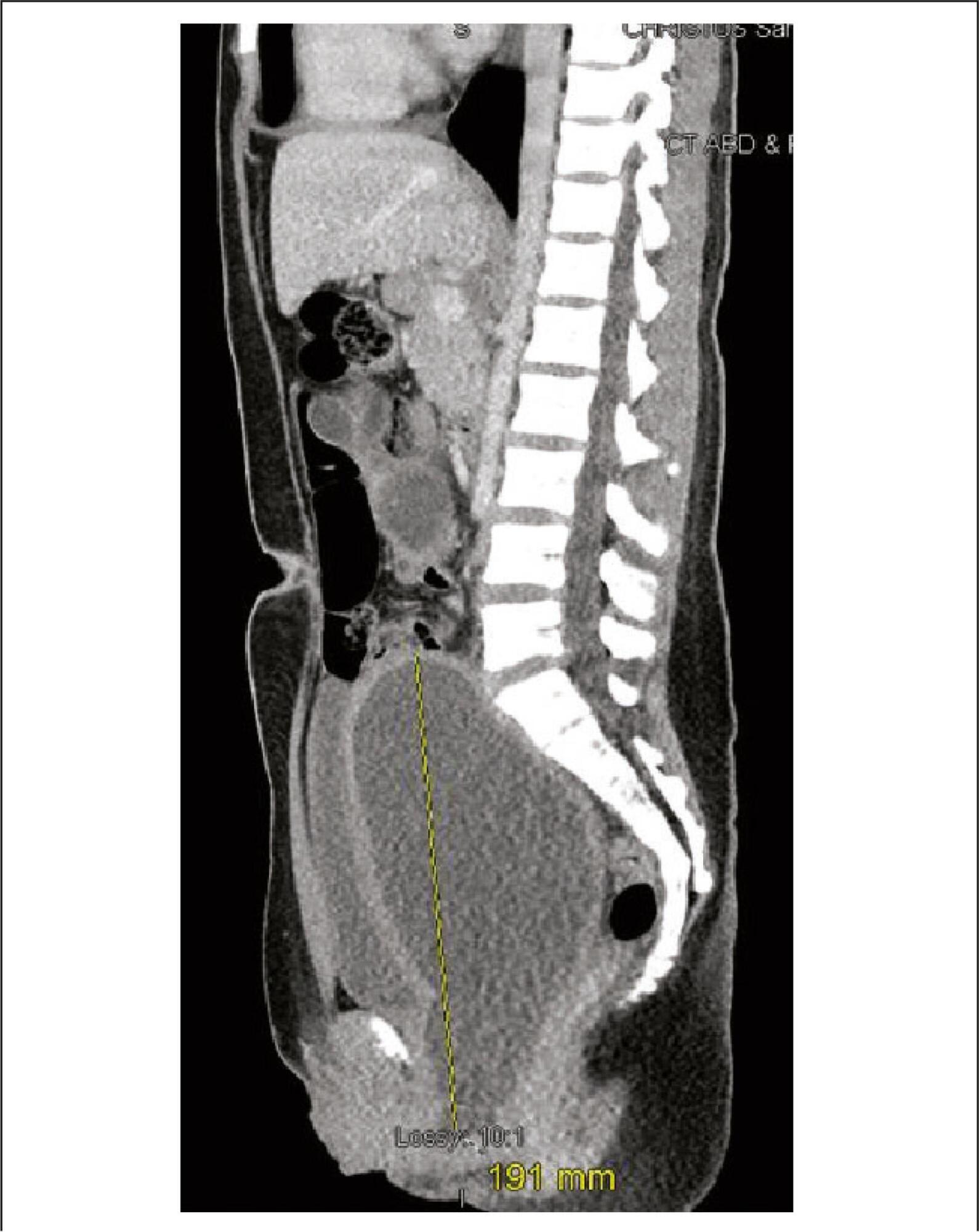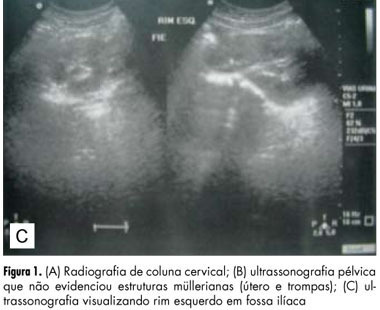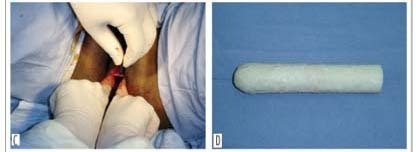Summary
Revista Brasileira de Ginecologia e Obstetrícia. 2015;37(4):192-196
DOI 10.1590/SO100-720320150005077
Herlyn-Werner-Wunderlich (HWW) syndrome is a rare congenital disorder of the Müllerian ducts in which there is uterus didelphys, obstructed hemivagina and unilateral renal agenesis. The most common presentation is an abdominal mass secondary to hematocolpos, pain and dysmenorrhea. However, in some cases, such as the one we present here, menses are normal due to an obstructed hemivagina, and diagnosis can be delayed. We describe evaluation and surgical management of a 13-year-old girl with this condition who was diagnosed by computed tomography (CT) scan and confirmed by pelvic ultrasound and surgical exploration, as well as a review of the literature.

Summary
Revista Brasileira de Ginecologia e Obstetrícia. 2012;34(6):274-277
DOI 10.1590/S0100-72032012000600006
PURPOSE: This study aimed to evaluate the results of neovaginoplasty by a modified McIndoe-Bannister technique and by the non-surgical Frank technique. METHODS: This retrospective study was conducted on a convenience sample of 25 women with vaginal agenesis undergoing surgical or conservative treatment at an Infant-Pubertal Gynecology Outpatient Clinic. Data were obtained from the medical records. Fifteen women underwent the surgical McIndoe-Bannister modified technique Surgical Group, and 10 women underwent the non-surgical Frank technique Frank Group. The following parameters were considered for comparative analysis between the two samples: vaginometry, surgical and non-surgical complications, and sexual satisfaction after treatment. Sexual satisfaction was assessed by a simple question: How is your sex life? RESULTS: There were differences related to vaginal length before and after performing exercises in both Frank Group (initial vaginal length 2.4±2.0 cm versus 6.9±1.1 cm after treatment, p<0.0001) and Surgical Group (initial vaginal length 0.9±1.4 cm versus 8.0±0.8 cm after treatment, p<0.0001). Increased vaginal length was observed in Surgical Group compared to Frank Group (Frank Group=7.0±0.9 cm versus Surgical Group=8.0±0.8 cm, p=0.0005). Forty percent of Surgical Group women had surgical complications versus no complications with the Frank technique. All women reported to be satisfied with their sexual life. CONCLUSION: The present data indicate that both the surgical and Frank techniques are effective for the treatment of vaginal agenesis, resulting in the construction of a vagina that pewrmits sexual intercourse and sexual satisfaction. The favorable aspects of the Frank technique are related to its low cost and to the low rates of major complications.
Summary
Revista Brasileira de Ginecologia e Obstetrícia. 2012;34(3):118-121
DOI 10.1590/S0100-72032012000300005
PURPOSE: To report the use of colpotomy for the treatment of ectopic pregnancies. METHODS: This was a retrospective cross-sectional study conducted on all women hospitalized with a clinical-laboratory suspicion of ectopic pregnancy who did not fulfill the criteria for drug treatment with methothrexate, during the period from February 2007 to August 2008. Demographic variables, gynecologic history and characteristics associated with treatment were obtained by reviewing the medical records. RESULTS: Eighteen women were included in the study. Mean age was 27±5.2 years. All patients presented ruptured ectopic pregnancy and all were submitted to partial salpingectomy. Surgical time ranged from 30 to 120 minutes (mean: 64.5 minutes) calculated from the moment when the patient entered the operating room to the moment when she left it. No patient presented postoperative infection. Mean time of hospitalization was 40±14.3 hours. The medications used during the postoperative period were similar in all cases, being based on nonsteroid anti-inflammatory drugs, dipyrone, paracetamol and meperidine, as needed. The diet was reintroduced 8 hours after the end of surgery. CONCLUSIONS: The use of colpotomy in the treatment of ectopic pregnancy showed good results, with the absence of important complications and a short hospitalization time. The basic surgical instruments needed for this procedure are relatively common to all hospitals, and the surgical technique is reproducible.
Summary
Revista Brasileira de Ginecologia e Obstetrícia. 2012;34(3):133-138
DOI 10.1590/S0100-72032012000300008
The atypical and more severe form of Mayer-Rokitansky-Kuster-Hauser syndrome (MRKH) or MRKH type II is also known as MURCS association, an acronym meaning aplasia/hypoplasia of Müllerian ducts (MU), congenital renal dysplasia (R) and cervico-thoracic dysplasia (CS). It affects female patients with normal karyotype and ovarian function, evolving to primary amenorrhea. It has an incidence of 1:50,000, but it is underestimated due to late diagnosis and undefined etiology. We describe the cases of a child and an adolescent in order to predict the diagnosis even in childhood, before the onset of amenorrhea. Patients had in common renal malformation, agenesis or hypoplasia of Müllerian derivatives and vertebral anomalies, establishing the diagnosis of MURCS. The relevance of this paper is to show the importance of further investigation when some of pathologic signs are present, researching correlated abnormalities in order to establish an early diagnosis and consequently to provide guidance to the patients and their families about the best way to conduct the case, including genetic counseling.

Summary
Revista Brasileira de Ginecologia e Obstetrícia. 2010;32(2):82-87
DOI 10.1590/S0100-72032010000200006
PURPOSE: to study the clinical and microbiological profile of women with bacterial vaginosis participating in a randomized, double-blind clinical trial, which compared the vaginal use of preparations from red pepper tree and metronidazole for the treatment of genital discharge. METHODS: the study was conducted on a series of 277 women with bacterial vaginosis concomitantly diagnosed by the criteria of Amsel and Nugent, selected from a total of 462 recruited patients using the information obtained before intervention. Data were analyzed with the Epi-Info 3.32 software. In order to compare the outcomes frequencies between the intervention groups, the χ2 test was used and the risk ratio and 95% confidence interval were calculated. The intention to treat analysis was performed. In addition to the determination of diagnostic parameters, the culture of vaginal content and a Papanicolaou cytology test were also performed. RESULTS: the most frequent clinical complaints were genital discharge, observed in 206 participants (74.4%) and the fish odor of the vaginal secretion, which occurred in 68.6% of the cases (190 patients). Among the diagnostic clinical criteria, the presence of clue-cells was positive in 275 women (99.3%), the Whiff test, in 266 (96.0%), followed by pH >4.5, which occurred in 92.8% of the cases, and by the presence of fluid grayish discharge reported by 206 participants (74.4%). Regarding the Nugent criterion, the median score was 8.0. Culture of the vaginal content permitted the identification of Gardnerella vaginalis in 96.8% of cases and of Mobiluncus in 53.1%. Only one third of the exams showed the presence of Lactobacillus (89 women - 32.1%). Fungal growth occurred in the cultures of 14 participants (5.1%). In most cases, culture revealed the presence of Corynebacterium (94.2%), Gram-positive cocci (98.2%), as well as Gram-positive (99.3%) and Gram-negative (91.0%) bacilli. Oncotic colposcopy revealed a very scarce presence of lactobacilli, which were present in only 8 cytological exams (2.9%) out of the total of 273 exams performed. CONCLUSIONS: the results of the present study did not differ from the literature regarding the symptoms reported by the women, the clinical criteria most frequently observed in the diagnosis, or the bacterial species detected in cultures of vaginal content. These findings indicate the need for further studies that might better elucidate the interrelations between the microbiological findings and the clinical expression of bacterial vaginosis.
Summary
Revista Brasileira de Ginecologia e Obstetrícia. 2009;31(4):189-195
DOI 10.1590/S0100-72032009000400006
PURPOSE: to identify species of lactobacillus isolated from the vaginal contents of healthy and asymptomatic women, determining the most prevalent species and characterizing them phenotypically. METHODS: lactobacillus have been isolated in selective milieu from samples of the vaginal contents of 135 women without complaints of vaginal secretion, and with negative laboratorial diagnosis of vaginal infection, followed up at an outpatient clinic. After being identified by multiplex PCR, the isolates have been submitted to RNAr 16S gene sequencing, when necessary. They have also been evaluated concerning the production of lactic acid, H2O2, bacteriocins and the ability to adhere to epithelial cells. RESULTS: eight-three lactobacillus strains were isolated and identified, L. crispatus (30.1%), L. jensenii (26.5%), L. gasseri (22.9%) e L. vaginalis (8.4%), being the prevalent species. Only 20 of those isolates did not present H2O2 production, in detectable amounts. From the 37 strains selected for the test of adhesion to the epithelial cells, 12 presented 50 to 69% of adhesion, 10 presented 70% or more, and the remaining, little or no adhesion at all. None of the tested strains produced bacteriocins. CONCLUSIONS: the lactobacillus species more prevalent in women without vulvovaginitis, isolated in selective culture milieu and identified by molecular methods were L. crispatus, L. jensenii and L. gasseri. Besides the fact of being more prevalent, these strains also presented better production of H2O2, and reached lower pH values in the culture milieu.
Summary
Revista Brasileira de Ginecologia e Obstetrícia. 2008;30(1):31-35
DOI 10.1590/S0100-72032008000100006
PURPOSE: to evaluate the use of natural latex mold (Hevea brasiliensis) as a modification of McIndoe and Bannister neovaginoplasty in patients presenting Mayer-Rokitansky-Küster-Hauser (MKRH) syndrome. METHODS: we retrospectively included nine patients presenting MKRH syndrome, who had been submitted to McIndoe and Bannister neovaginoplasty modified by the use of natural latex mold. Neovaginal epithelization and depth, coitus occurrence and satisfaction, and surgical complications were evaluated. RESULTS: five weeks after the procedure, eight patients presented an epithelized 7 to 12 cm deep neovagina. There was one case of complete neovaginal stenosis, because of incorrect use of the mold. After at least one year, the others maintained 4 to 8 cm deep neovaginas and capacity for intercourse, with 66.7% satisfaction. One woman presented precocious rectovaginal fistula and late episodes of uretrovaginal fistulae. Two patients presented distal neovaginal stenosis in long-term follow-up. One of these and the patient with fistulae were submitted to a new procedure. CONCLUSIONS: the use of natural latex mold as a modification of classic neovaginoplasty technique allows the creation of neovaginas morphologically and functionally similar to the normal vagina in patients with vaginal agenesis.

Summary
Revista Brasileira de Ginecologia e Obstetrícia. 2007;29(12):619-624
DOI 10.1590/S0100-72032007001200004
PURPOSE: to evaluate the results of neovaginoplasty with the use of a human amniotic graft in patients with the Mayer-Rokitansky-Küster-Hauser (MRKH) syndrome. METHODS: the study was a retrospective analysis of a series of 28 patients with the MRKH syndrome conducted from 1990 to 2003. The patients were attended and treated at the Ambulatório de Ginecologia Infanto-Puberal (AGIP) of the Hospital Universitário of the Faculdade de Medicina de Ribeirão Preto of the Universidade de São Paulo (FMRP-USP), being submitted to neovaginoplasty by the technique of McIndoe and Bannister, modified by the use of a human amniotic membrane graft. Epithelization, amplitude and depth of the neovaginas were evaluated 7 and 40 days after the procedure. Patient satisfaction was determined during the late postoperative period in terms of the presence of discomfort and dyspareunia during sexual relations. RESULTS: postoperatively, seven patients (25%) presented vaginal stenosis and six of them were submitted to a new surgical intervention, one had shortening of the neovagina, corrected with the use of exercises with a vaginal mold, three (10.7%) developed a rectovaginal fistula, one (3.6%) a uterovesical fistula, and one (3.6%) excess skin in the vaginal introitus - all successfully corrected with surgery. Four patients (14.3%) presented urinary tract infection. Two months after surgery, 11/19 patients (57.8%) presented satisfactory sexual activity and 42% dyspareunia, and within a maximum period of four years, 20/21 patients (95.2%) had satisfactory sexual activity and 4.8% dyspareunia. CONCLUSIONS: an amniotic membrane graft is a good option for the treatment of vaginal agenesis. Perioperative follow-up involves educational guidance regarding the use of the mold and regarding patient sexuality in order to reduce the complaints of dysfunctional coitus in the presence of a favorable surgical evolution and a neovagina of adequate aspect.
